
The Dytiscidae – based on the Greek dytikos (δυτικός), "able to dive" – are the predaceous diving beetles, a family of water beetles. They occur in virtually any freshwater habitat around the world, but a few species live among leaf litter. The adults of most are between 1 and 2.5 cm (0.4–1.0 in) long, though much variation is seen between species. The European Dytiscus latissimus and Brazilian Megadytes ducalis are the largest, reaching up to 4.5 cm (1.8 in) and 4.75 cm (1.9 in) respectively. In contrast, the smallest is likely the Australian Limbodessus atypicali of subterranean waters, which only is about 0.9 mm (0.035 in) long. Most are dark brown, blackish, or dark olive in color with golden highlights in some subfamilies. The larvae are commonly known as water tigers due to their voracious appetite. They have short, but sharp mandibles and immediately upon biting, they deliver digestive enzymes into prey to suck their liquefied remains. The family includes more than 4,000 described species in numerous genera.

Ulmus crassifoliaNutt., the Texas cedar elm or simply cedar elm, is a deciduous tree native to south-central North America, mainly in southern and eastern Texas, southern Oklahoma, Arkansas, and Louisiana, with small populations in western Mississippi, southwest Tennessee, and north-central Florida; it also occurs in northeastern Mexico. It is the most common elm tree in Texas. The tree typically grows well in flat valley bottom areas referred to as cedar elm flats. Its Latin name refers to its comparatively thick (crassifoliate) leaves; the common name cedar elm is derived from the trees' association with juniper trees, locally known as cedars.

Ochodaeidae, also known as the sand-loving scarab beetles, is a small family of scarabaeiform beetles occurring in many parts of the world.
Chionodes petalumensis is a species of moth in the family Gelechiidae. It is found in North America from southern British Columbia to California, Arizona and Colorado.
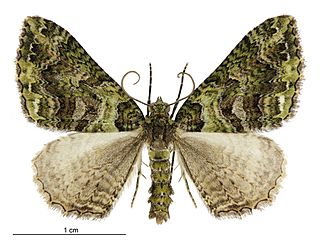
Austrocidaria similata is a species of moth of the family Geometridae. It endemic to New Zealand.
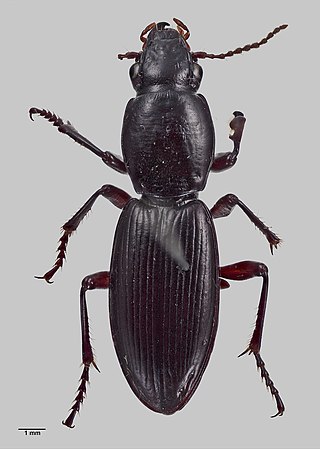
Bountya insularis is a species of beetle in the family Carabidae, the only species in the genus Bountya. Both the genus and species was first described by J. I. Townsend in 1971 from specimens collected by E. G. Turbott on Bounty Island on 11 November 1950. The holotype specimen is in the entomology collection of the Auckland War Memorial Museum.

Thomas Broun was a Scottish-born soldier, farmer, teacher and entomologist, who spent much of his career in New Zealand. He is known for his study of the beetles (Coleoptera) of New Zealand.

Declana atronivea, commonly called the North Island lichen moth or North Island zebra moth, is a moth of the family Geometridae. It is endemic to New Zealand and found only in the North Island.

Evan Graham Turbott was a New Zealand ornithologist, zoologist, and museum administrator. He served as director of the Auckland Institute and Museum from 1964 to 1979.
Corinne Hannah Watts is a New Zealand entomologist and ecologist. Specimens collected by Watts are held at Museum of New Zealand Te Papa Tongarewa.
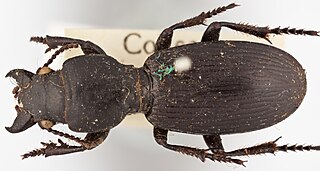
Mecodema curvidens Broun is a medium-bodied ground beetle that is geographically widespread throughout the central areas of the North Island, New Zealand, which includes the entomological regions of Auckland (AK), Waikato (WO), Coromandel (CL), Bay of Plenty (BP), Taupo (TO), Rangitikei (RI), Whanganui (WI), Hawkes Bay (HB) and Wellington (WN). Recently, the species M. occiputale Broun was synonymised under M. curvidens. Mecodema curvidens is relatively common through its range except in the southern area of the Hunua Ranges (Auckland) and Wellington regions.
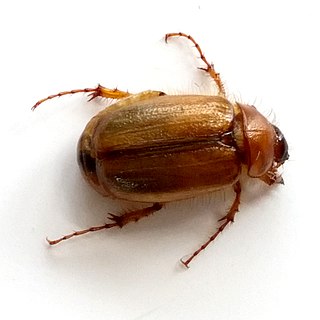
Costelytra zealandica is a species of scarab beetle found in forested areas of greater Wellington. It was originally described in 1846 by the British entomologist Adam White as Rhisotrogus zealandicus from a specimen obtained during the Ross expedition. The species is known to feed on roots of plants and trees, so is considered a pest for many farm pastures.

Mimopeus is a genus of darkling beetles in the family Tenebrionidae, first described by Francis Polkinghorne Pascoe in 1866. It is endemic to New Zealand.
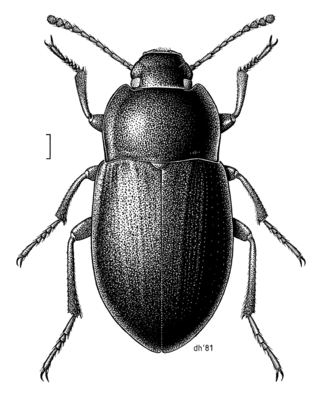
Mimopeus elongatus is a species of darkling beetle in the subfamily Tenebrioninae, first described by Ferdinando Arborio Gattinara di Breme in 1842, who considered it a type of Cilibe.

Mimopeus neglectus is a species of darkling beetle in the subfamily Tenebrioninae, first described by J. C. Watt in 1988. It occurs around the Cook Strait area of New Zealand, on both the North and South Islands.

Gyrinus convexiusculus is a species of whirligig beetle in the family Gyrinidae, first described by Macleay in 1871.

Tingena plagiatella is a species of moth in the family Oecophoridae. It is endemic to New Zealand and has been observed in both the North and South Islands. This species inhabits light native bush or scrubland. Adults of this species are on the wing from November to January.
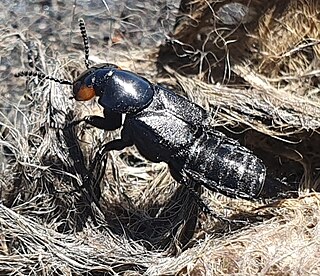
Creophilus oculatus or devil's coach horse is a species of large carrion-feeding rove beetle endemic to New Zealand.
Charles Edwin Clarke was a New Zealand dentist and amateur entomologist, who specialised in collecting lepidoptera and coleoptera.

Mimopeus turbotti is a species of darkling beetle belonging to the family Tenebrionidae. The species was first described by John Charles Watt in 1988, and is endemic to Manawatāwhi / Three Kings Islands in New Zealand.

















